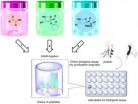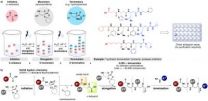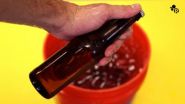(Press-News.org) Chemists at ETH-Zürich and ITbM, Nagoya University have developed a new method to build large libraries of bioactive molecules – which can be used directly for biological assays – by simply mixing a small number of building blocks in water.
Zürich, Switzerland and Nagoya, Japan – Professor Jeffrey Bode of ETH-Zürich and the Institute of Transformative Bio-Molecules (ITbM) of Nagoya University, and his co-worker have established a new strategy called "synthetic fermentation" to rapidly synthesize a large number of bioactive molecules, which can be directly screened in biological assays simply by mixing a few building blocks in aqueous media. Using a highly selective amide-forming ligation, the reaction proceeds in high efficiency in the absence of organisms, enzymes or reagents. The fermentation products can be screened directly for biological activity without any purification. Synthetic fermentation has enabled the generation of about 6,000 unnatural peptide-like molecules from only 23 building blocks. The practicality of this approach is shown by identifying a bioactive compound for inhibiting an enzyme responsible for the replication of the hepatitis C virus. The study, published online on September 7, 2014 in Nature Chemistry as an Advanced Online Publication, is expected to be a powerful and practical method to allow rapid generation and screening of active molecules useful for drug discovery and other industrial applications as well as for simple biological assays on site.
Microbial fermentation is a metabolic process by which microbes synthesize complex organic substances like antibiotics from simple organic building blocks. This process is known to be one of the most successful methods to discover biologically active compounds. "We were inspired by Nature's approach to rapidly generate complex molecules by microbial fermentation, so we considered the possibility of using synthetic organic chemistry to prepare and screen libraries of bioactive peptides, a method that we call synthetic fermentation", says Prof. Bode who led the research. Organic synthesis often involves many time-consuming steps, the use of toxic reagents to initiate the reaction, and requires difficult purification prior to biological screening. "Instead of using reagents or enzymes to combine simple building blocks into complex molecules, we decided to synthesize such molecules by synthetic fermentation with our chemical reactions using carefully designed precursors", says Prof. Bode. In order to accomplish this, Prof. Bode applied his unique KAHA (α-ketoacid-hydroxylamine) ligation developed by his group in 2006. KAHA ligation enables highly efficient coupling between an α-ketoacid molecule and a hydroxylamine molecule by forming an amide (N(H)C=O) bond in aqueous media without any additional reagents. Synthetic fermentation, which uses KAHA ligation chemistry, enables the construction of libraries of compounds that would be challenging to prepare by either traditional organic synthesis or by microbial fermentation.
In synthetic fermentation, an α-ketoacid initiator (I) molecule is mixed with isooxazolidine elongation monomers (M) that builds chains of peptides, which is finally stopped by adding a terminator (T) building block. A new α-ketoacid is generated each time a monomer (M) is added to the growing peptide chain, which reacts with another monomer (M) leading to peptides of varying length and sequence. After adding a terminator (T) molecule, the peptide chain cannot grow any further. "We initially chose to work with 23 building blocks, including 6 initiators (I), 8 monomers (M), and 9 terminators (T), which can lead to around 30,000 compounds from all possible combinations of building blocks. In this study, we have made 6,000 compounds by selected combinations. By increasing the number of building blocks, we can dramatically expand the number of potential compounds that can be formed", explains Prof. Bode. The resulting 'culture', containing peptide chains, cyclohexanone by-products and small amounts of the terminator (T) molecule, which is added in slight excess, can be diluted with buffer and directly subjected to biological screening. "To the best of our knowledge, there is currently no synthetic method to prepare such large numbers of compounds from relatively few starting materials by simply mixing building blocks followed by direct biological assays", says Prof. Bode.
Bode's group demonstrates the applicability of synthetic fermentation by preparing synthetic cultures and screening them to find biologically active lead molecules for the inhibition of HCV (Hepatitis C virus) protease. HCV protease is an enzyme having a key role in the replication of the hepatitis C virus. As this enzyme lacks a well-defined pocket in its active site, this is a challenging target for finding bioactive hit molecules. "We have 'grown' our cultures for screening using various combinations of initiators (I), monomers (M) and terminators (T) and have performed assays in well plates. From the assay results, we eliminated the poorly performing moieties and rapidly deconvoluted the mixtures found in active wells to identify the combinations of components that lead to the active products", describes Prof. Bode.
Prof. Bode says, "The hardest part of this work was looking beyond the entrenched idea that we needed single, pure compounds to do the biological screening. It was only when we looked at the way Nature makes new medicines – by producing dozens of similar compounds together – that we realized we could use our chemistry to do something very similar. By taking this inspiration, we found that we could make thousands of compounds from a few building blocks in a few hours, rather than the months it would normally take."
Synthetic fermentation enables the rapid formation of a vast number of compounds from readily available building blocks that can be screened to find active hit molecules. "At ITbM, we hope to apply this approach for phenotypic assays, in order to identify small molecules that alter the characteristics of cells and organisms with biologists", says Prof. Bode. The synthetic fermentation approach may also be useful in the fields of materials science and catalysis to identify potent peptides. "These studies show that simply by mixing compounds, anyone can create new molecules and test them in simple biological assays like anti-fungal or anti-bacterial screens. This is possible because of our very unique chemistry of the KAHA ligation developed in our group. Our idea is to provide a quick way to make bioactive molecules just by mixing the components in water. We would like to use this as a platform for chemistry that anyone can do, including scientists in other fields, high school students and farmers. Anyone could prepare libraries in a few hours with a micropippete, explore different combinations of building blocks and culture conditions along with simple assays to find novel molecules", says Prof. Bode.
INFORMATION:
This article "Synthetic fermentation of bioactive non-ribosomal peptides without organisms, enzymes or reagents" by Yi-Lin Huang and Jeffrey W. Bode is published online on September 7, 2014 in Nature Chemistry as an Advanced Online Publication.
DOI: 10.1038/nchem.2048
About WPI-ITbM
The World Premier International Research Center Initiative (WPI) for the Institute of Transformative Bio-Molecules (ITbM) at Nagoya University in Japan is committed to advance the integration of synthetic chemistry, plant/animal biology and theoretical science, all of which are traditionally strong fields in the university. As part of the Japanese science ministry's MEXT program, ITbM aims to develop transformative bio-molecules, innovative functional molecules capable of bringing about fundamental change to biological science and technology. Research at ITbM is carried out in a "Mix-Lab" style, where international young researchers from multidisciplinary fields work together side-by-side in the same lab. Through these endeavors, ITbM will create "transformative bio-molecules" that will dramatically change the way of research in chemistry, biology and other related fields to solve urgent problems, such as environmental issues, food production and medical technology that have a significant impact on the society.
'Pick 'n' Mix' chemistry to grow cultures of bioactive molecules
2014-09-08
ELSE PRESS RELEASES FROM THIS DATE:
Trial shows improved overall survival for patients with liver cancer not amenable to surgery
2014-09-08
Singapore, 04 September 2014 – The mature results from a trial conducted by the Asia-Pacific Hepatocellular Carcinoma Trials Group led by the National Cancer Centre Singapore (NCCS) and Singapore General Hospital (SGH) have shown that patients who suffer from inoperable advanced hepatocellular carcinoma (HCC) may have a chance to live significantly longer by using a combined therapy.
The multi-centre phase II clinical trial was conducted at four Asia Pacific tertiary medical centres to evaluate the efficacy of combining two existing treatment modalities, Sorafenib and ...
New knowledge of cannabis paves the way for drug development
2014-09-08
Revolutionary nanotechnology method could help improve the development of new medicine and reduce costs. Researchers from the Nano-Science Center and the Department of Chemistry at the University of Copenhagen have developed a new screening method that makes it possible to study cell membrane proteins that bind drugs, such as cannabis and adrenaline, while reducing the consumption of precious samples by a billion times.
About 40% of all medicines used today work through the so-called "G protein-coupled receptors". These receptors react to changes in the cell environment, ...
Study examines discrimination among homeless adults in Toronto with mental illness
2014-09-08
TORONTO, Sept. 8, 2014—Vulnerable populations in ethnically diverse Toronto reported more discrimination by health care workers based on their housing status, mental health or substance abuse issues than race, a new study has found.
Forty-two per cent of people surveyed reported at least one form of perceived discrimination by health care workers, lead author Dr. Vicky Stergiopoulos wrote in a paper published today in the journal BMC Health Services Research.
The most prevalent form of perceived discrimination was due to mental illness or substance abuse (33 per cent) ...
Poor recording of physical health and medication could be causing dementia trials to fail
2014-09-08
Dementia trials could be failing because they all-too-often overlook the physical health of patients – according to new research from the University of East Anglia and Aston University.
More than 60 per cent of people with dementia are estimated to have three or more other conditions (co-morbidities).
The research shows how the combined effects of co-morbidities including diabetes, lung disease, arthritis and chronic heart failure are not being adequately described in dementia trials.
It investigates the extent of co-morbidities in people with dementia and the recording ...
Food craving is stronger, but controllable, for kids
2014-09-08
Children show stronger food craving than adolescents and adults, but they are also able to use a cognitive strategy that reduces craving, according to new research published in Psychological Science, a journal of the Association for Psychological Science.
"These findings are important because they suggest that we may have another tool in our toolbox to combat childhood obesity," says psychological scientist and lead researcher Jennifer A. Silvers, a post-doctoral fellow at Columbia University in the laboratory of Professor Kevin Ochsner.
Most interventions aimed at ...
Quick-cooled beers, perfect burgers and more: Chemistry Life Hacks, Vol. 3 (video)
2014-09-08
WASHINGTON, September 8, 2014 — It's the series that's one-part MacGyver, one-part Mendeleev. "Chemistry Life Hacks" is back with new tips that can change your life, or at least the temperature of your beer. Learn how to cool your brews quickly before the big game starts, get fruit flies out of your kitchen for good, and how to cook the perfect patty on the grill. Check out these tips and more at: http://youtu.be/QUE2O1276P8.
Subscribe to the series at Reactions YouTube, and follow us on Twitter @ACSreactions to be the first to see our latest videos.
INFORMATION:
The ...
Layered graphene sandwich for next generation electronics
2014-09-08
Writing in Nature Nanotechnology, the researchers have demonstrated how combining the two-dimensional materials in a stack could create perfect crystals capable of being used in next generation transistors.
Hexagonal boron nitride (hBN), otherwise known as white graphene, is one of a family of two-dimension materials discovered in the wake of the isolation of graphene at the University in 2004. Manchester researchers have previously demonstrated how combining 2D materials, in stacks called heterostructures, could lead to materials capable of being designed to meet industrial ...
Light detector to revolutionize night vision technology
2014-09-08
Researchers have developed a light detector that could revolutionise chemical sensing and night vision technology.
In the latest issue of Nature Nanotechnology, the team of researchers at Monash University, the University of Maryland in the US, and the US Naval Research Laboratory, have created the light detector based on graphene – a single sheet of interconnected carbon atoms.
The detector is capable of detecting light over an unusually broad range of wavelengths, included in this are terahertz waves – between infrared and microwave radiation, where sensitive light ...
Doped graphene nanoribbons with potential
2014-09-08
Graphene is a semiconductor when prepared as an ultra-narrow ribbon – although the material is actually a conductive material. Researchers from Empa and the Max Planck Institute for Polymer Research have now developed a new method to selectively dope graphene molecules with nitrogen atoms. By seamlessly stringing together doped and undoped graphene pieces, they were able to form "heterojunctions" in the nanoribbons, thereby fulfilling a basic requirement for electronic current to flow in only one direction when voltage is applied – the first step towards a graphene transistor. ...
Bacteria from bees possible alternative to antibiotics
2014-09-08
Raw honey has been used against infections for millennia, before honey - as we now know it - was manufactured and sold in stores. So what is the key to its' antimicrobial properties? Researchers at Lund University in Sweden have identified a unique group of 13 lactic acid bacteria found in fresh honey, from the honey stomach of bees. The bacteria produce a myriad of active antimicrobial compounds.
These lactic acid bacteria have now been tested on severe human wound pathogens such as methicillin-resistant Staphylococcus aureus (MRSA), Pseudomonas aeruginosa and vancomycin-resistant ...





